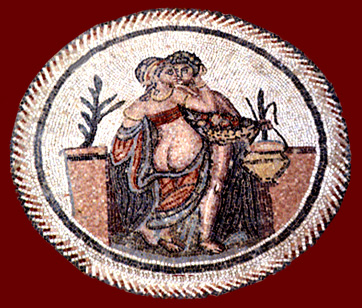 |
The fast-food and hospitality industry provided work for slaves and women of the lower classes who were poor or had to earn a living for their birth or marriage families. While prostitution was more lucrative than waitressing or shopkeeping, social and legal penalties encouraged practitioners to hide behind these businesses. Graffiti and later legal codes (see Digesta) make it clear that thermopolia and cauponae (taverns and inns) became fronts for prostitution or were believed to be in the flesh trade. A woman who practiced prostitution or employed prostitutes automatically incurred infamia (loss of reputation and some legal rights); free-born Roman citizens were not allowed to contract a fully valid marriage with her, though a freedman could if she retired from prostitution. If she was married when she began to practice prostitution, she was considered an adulteress, and her husband had to divorce her or incur infamia for acting as a pimp. Augustus' Lex Iulia de Maritandis forbade members of a senatorial family from marrying freedwomen, actresses, prostitutes, madams, or adulterers; however, it is probable that the law would be invoked primarily against the elite rather than someone of the lower classes. |
| (6) | Lenocinium facere non minus est quam corpore quaestum exercere. | |
| (7) | Lenas autem eas dicimus, quae mulieres quaestuarias prostituunt. | |
| (8) | Lenam accipiemus et eam, quae alterius nomine hoc vitae genus exercet. | |
| (9) |
Si qua cauponam exercens in ea corpora quaestuaria habeat (ut multae adsolent sub praetextu instrumenti cauponii prostitutas mulieres habere), dicendum hanc quoque lenae appellatione contineri | |
Click on the underlined words for translation aids and
commentary, which will appear in a small window. Close the small window after
each use. Click on the icon link
![]() to the right of the
poem for related images and information. Close the small window after each use.
to the right of the
poem for related images and information. Close the small window after each use.